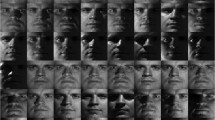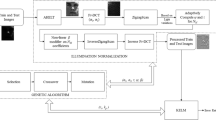Abstract
Illumination Variation and wearable objects loses the partial facial information that it degrades the accuracy of recognition process. In this paper, a high performance driven accurate method is provided for facial recognition. The proposed MFAST (Multi-Featured Analog Signal Transformed) Model genuinely transmute the substantial facial information in analog featured conformation. This analog featured structured is formed using segmented featured elicitation. These features include center difference evaluation as moment, the asymmetric structure analysis as Skewness and Outlier Prone Measure as Kurtosis. These analogous features are shaped to justified form and generate a compound signal form. Mapping of these distillates signal points over facial dataset with specification of threshold window. The decomposed form recognition method enhanced the accuracy and performance. The experimentation on FERET, LFW and Indian Databases signify that the model outperformed than existing algorithms.
Access this chapter
Tax calculation will be finalised at checkout
Purchases are for personal use only
Similar content being viewed by others
References
Lee, M., Park, C.H.: An efficient image normalization method for face recognition under varying illuminations. In: Proceedings of the 1st ACM International Conference on Multimedia Information Retrieval, pp. 128–133 (2008)
Kim, W., Suh, S., Hwang, W., Han, J.-J.: SVD face: illumination-invariant face representation. IEEE Signal Process. Lett. 21(11), 1336–1340 (2014)
Han, Z., Fang, C., Ding, X.: A discriminated correlation classifier for face recognition. In: Proceedings of the 2010 ACM Symposium on Applied Computing, pp. 1485–1490 (2010)
Xu, Y., Fang, X., Yang, J., You, J., Liu, H., Teng, S.: Data uncertainty in face recognition. IEEE Trans. Cybern. 44(10), 1950–1961 (2014)
Hu, H.: Face recognition with image sets using locally grassmannian discriminant analysis. IEEE Trans. Circuits Syst. Video Technol. 24(9), 1461–1474 (2014)
Wan, J., Yang, M., Gao, Y., Chen, Y.: Pairwise costs in semisupervised discriminant analysis for face recognition. IEEE Trans. Inf. Forensics Secur. 9(10), 1569–1580 (2014)
Kekre, H.B., Sarode, T.K., Natu, P.J., Natu, S.J.: Transform based face recognition with partial and full feature vector using DCT and walsh transform. In: International Conference and Workshop on Emerging Trends in Technology, pp. 1295–1300 (2011)
De Marsico, M., Nappi, M., Riccio, D.: Measuring sample distortions in face recognition. In: Proceedings of the 2nd ACM Workshop on Multimedia in Forensics, Security and Intelligence, pp. 83–88 (2010)
Rong, J., Gritti, T., Shan, C.: Upscaling faces for recognition systems using trained filters. In: Proceedings of the 1st International Workshop on Interactive Multimedia for Consumer Electronics, pp. 105–112 (2009)
Divya, R., Rath, A., Manikantan, K., Ramachandran, S.: Astroid shaped DCT feature extraction for enhanced face recognition. In: Proceedings of the CUBE International Information Technology Conference, pp. 95–101 (2012)
Wang, J., Lu, C., Wang, M., Yan, S., Hu, X.: Robust face recognition via adaptive sparse representation. IEEE Trans. Cybern. 44(12), 2368–2378 (2014)
Xu, Y., Li, X., Yang, J., Lai, Z., Zhang, D.: Integrating conventional and inverse representation for face recognition. IEEE Trans. Cybern. 44(10), 1738–1746 (2014)
Girgensohn, A., Adcock, J., Wilcox, L.: Leveraging face recognition technology to find and organize photos. In: Proceedings of the 6th ACM SIGMM International Workshop on Multimedia Information Retrieval, pp. 99–106 (2004)
Hu, S., Maschal, R., Young, S.S., Hong, T.H., Phillips, J.P.: Performance assessment of face recognition using super-resolution. In: Proceedings of the 10th Performance Metrics for Intelligent Systems Workshop, pp. 195–200 (2010)
Author information
Authors and Affiliations
Corresponding author
Editor information
Editors and Affiliations
Rights and permissions
Copyright information
© 2016 Springer Science+Business Media Singapore
About this paper
Cite this paper
Juneja, K. (2016). MFAST Processing Model for Occlusion and Illumination Invariant Facial Recognition. In: Choudhary, R., Mandal, J., Auluck, N., Nagarajaram, H. (eds) Advanced Computing and Communication Technologies. Advances in Intelligent Systems and Computing, vol 452. Springer, Singapore. https://doi.org/10.1007/978-981-10-1023-1_16
Download citation
DOI: https://doi.org/10.1007/978-981-10-1023-1_16
Published:
Publisher Name: Springer, Singapore
Print ISBN: 978-981-10-1021-7
Online ISBN: 978-981-10-1023-1
eBook Packages: EngineeringEngineering (R0)




